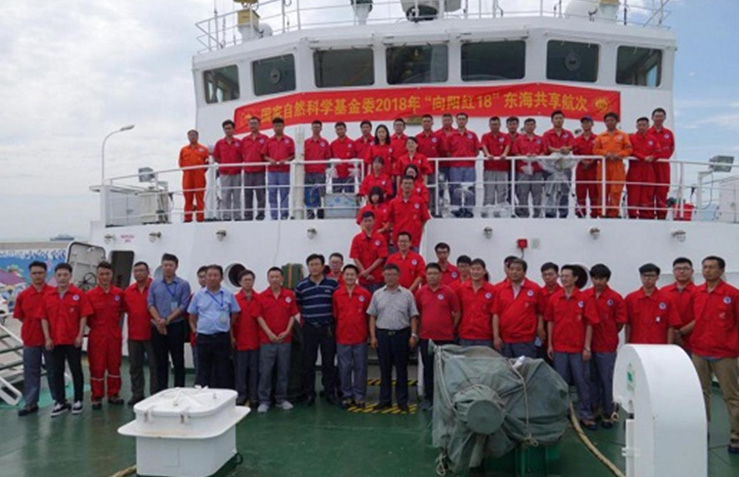"Xiang Yang Hong 18" Successfully Completed the 2018 Autumn Shared Voyage of Experimental Study of the East China Sea Conducted by National Natural Science Foundation of China
On September 20, "Xiang Yang Hong 18", a scientific expedition ship, successfully completed the 2018 autumn shared voyage of experimental study of the East China Sea conducted by National Natural Science Foundation of China and reach the port.
This voyage set sail from Qingdao on September 5, 2018 and sailed over 1,800 nautical miles over 16 days. More than 30 members of scientific expedition participated in the voyage. They came from 12 entities, including Institute of Oceanology of the Chinese Academy of Sciences, the First Institute of Oceanography, SOA, Ocean University of China, East China Normal University, Fudan University, Tongji University, China University of Geosciences, Shanghai Ocean University, Qingdao Institute of Bioenergy and Bioprocess Technology, Chinese Academy of Science, Zhejiang Ocean University, Tianjin University of Science and Technology, and East China University of Science and Technology. The voyage mainly focused on scientific problems such as the evolution of marine environment and ecosystem response of the East China Sea shelf under the dual functions of human activities and global changes. We have implemented CTD measurement, voyage ADCP, shipborne weather research, standard layer and large volume water collection, and box-type and gravity pillar dredging. A total of 6 sections and 42 stations have been investigated. Meanwhile, the first-hand on-site investigation data and samples were obtained for the funded project, providing strong support to relevant research work.
Voyage Photo |
As the entity responsible for the scientific investigation mission of the East China Sea, our institution, based on scientific, rational, economic and fair design principles of the shared voyage conducted by National Natural Science Foundation of China, fully used advantages of shipborne equipment on the "Xiang Yang Hong 18", optimized the route and working sequence of survey stations, and established implementation mechanism of multi-task coordination, investigation work safety and efficiency, and full sharing of basic data, guaranteeing the quality and quantity of on-site sampling and analysis work.
Box-type dredging CTD and water collection |
During the voyage, the ship encountered the super typhoon "Mangkhut". The temporary Party branch paid close attention to the typhoon trend in real time. After discussions and adjustments, a reasonable route was planned and the effective use of the ship on sea was realized under the guarantee of safety. Before the ship taking shelter from the wind, the sea situation of the East China Sea became worse. For the sudden bad weather, some of the young team members showed symptoms of seasickness, either light or heavy. In view of this situation, the temporary Party branch of the voyage cooperated with the ship doctors to explain the methods to relieve the symptoms of seasickness, and provided the crew with drugs for reducing seasickness, such as seasickness medicine and seasickness patch, to help everyone overcome the effects of physical discomfort. They finally completed the scheduled tasks successfully.
Next, we will timely complete the processing and quality control of basic shared data, such as CTD, five inorganic nutrient salts of water, chlorophyll a, automatic weather station, and voyage ADCP according to the task schedule. The results will be shared within the fund project and be delivered to Qingdao Marine Science Information Sharing Service Center of Natural Science Foundation of China, realizing the sharing utilization of voyage investigation data.




